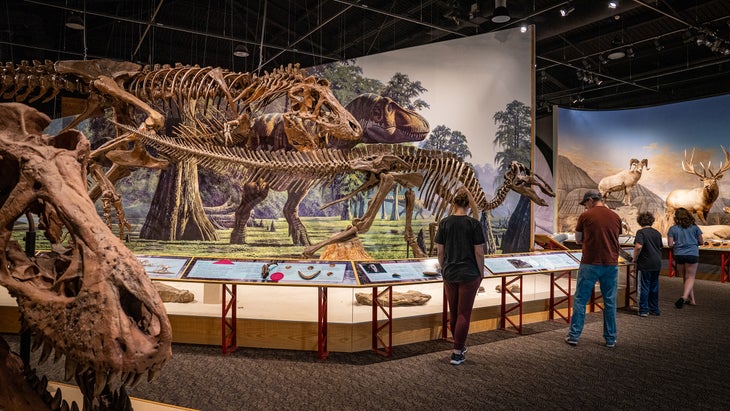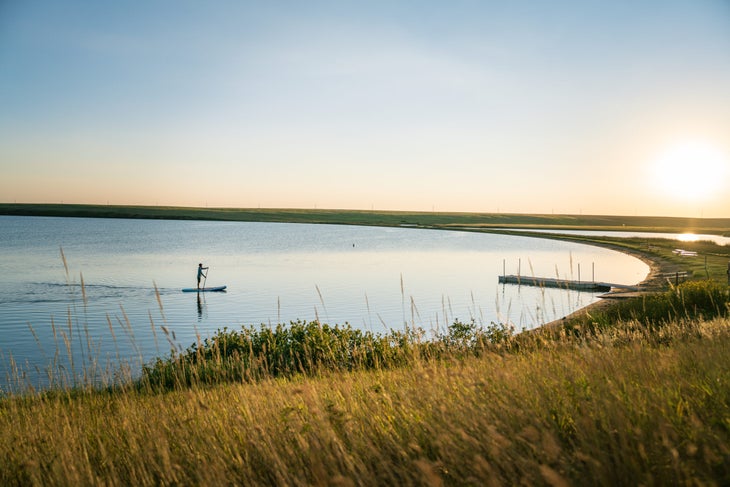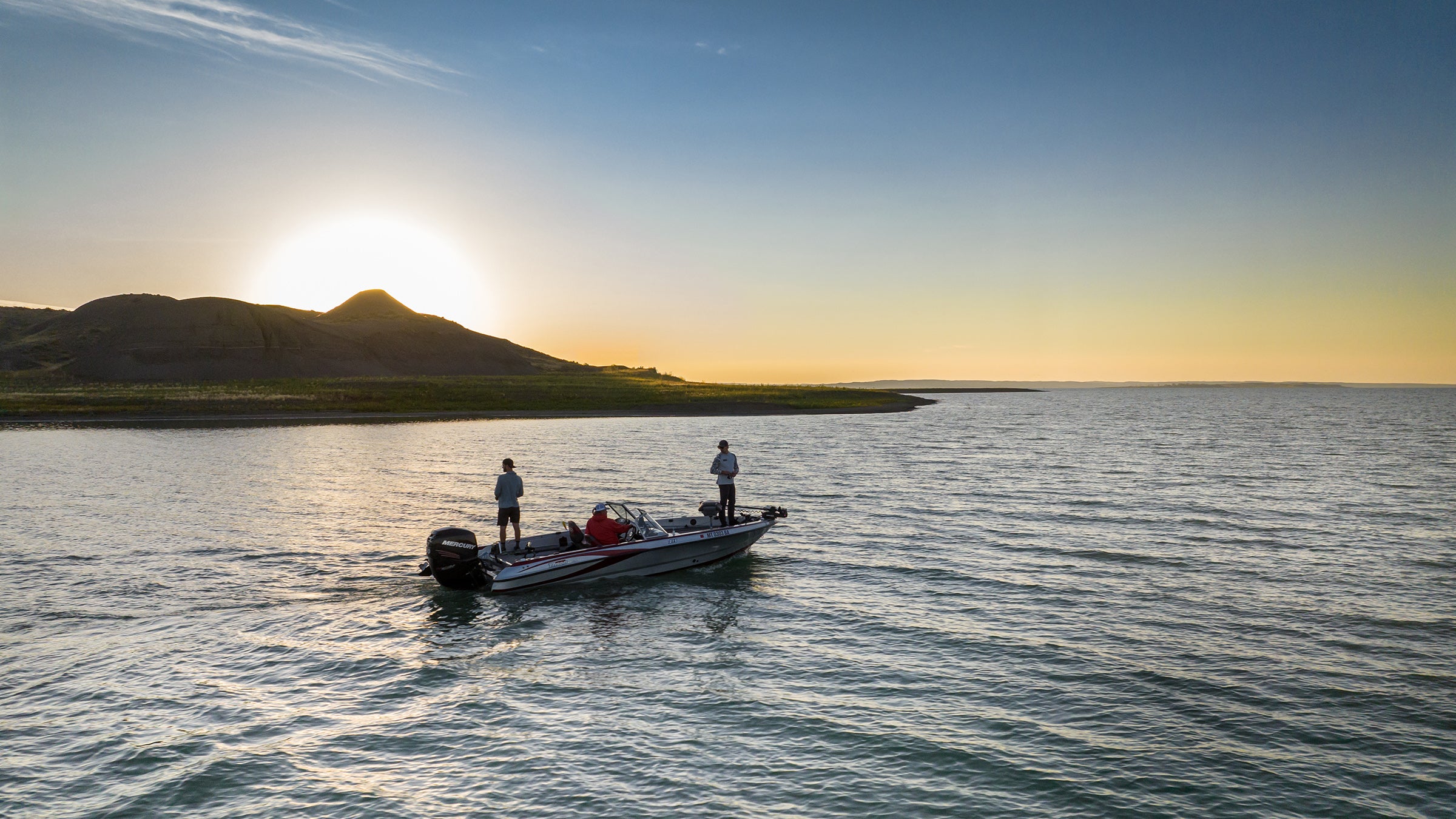Northeast Montana is a place where vast expanses of prairie are punctuated by badlands, river breaks, and welcoming small towns. Two mighty waterways—the Yellowstone and the Missouri—course through the region, offering boundless opportunities for recreation, relaxation, and historical immersion.
Glasgow
According to a mural painted on the facade of one of its buildings, Glasgow is in “the middle of nowhere.” That may be true, but it’s also the gateway to the best of Montana’s Missouri River Country. The town, which grew as a result of the nearby Fort Peck Dam project during the Great Depression, oozes Americana—its Art Deco buildings, grain silos, and railroad tracks transporting you to that era. Traveling with kids? Head to the hands-on exhibits at the .
Eat and Stay: You’d expect to find choice steaks and burgers in a place like Glasgow. But authentic thin-crust pizza? Prepare to be pleasantly surprised at Eugene’s Pizza. If you’re thirsty afterward, drop by Busted Knuckles for a local craft brew. Stay at the Cottonwood Inn and Suites and experience genuine Montana hospitality.
Fort Peck and Fort Peck Lake
Western towns tend to fall into one of a handful of buckets. There are cow towns, industrial centers, railroad hubs, trading posts, and so on. Fort Peck, built by the Army Corps of Engineers in the early 1930s to house its employees during construction of the Fort Peck Dam, is an outlier. Though originally designed to be temporary, Fort Peck lives on today as both a thriving year-round community and a vacation destination.

Head first to the Fort Peck Interpretive Center for a deep dive into the construction of what was then the world’s largest earthen dam. (It’s still the largest such dam in the country.)
The project, which at its height employed more than 10,000 workers, was the subject of Time magazine’s inaugural cover story in 1936. But that’s just one of many exhibits at the Fort Peck Interpretive Center. There’s also a full-size model of Peck’s Rex, a nearly complete T. rex fossil found in the area; floor-to-ceiling freshwater aquariums housing native fish species; and ecology displays showcasing some of the many wildlife species found in the C.M. Russell National Wildlife Refuge, which surrounds much of Fort Peck Lake.
Covering nearly 250,000 acres, Fort Peck Lake is like an ocean in the middle of Montana —it’s the fifth largest artificial lake in the United States. And with more coastline than California, the lake offers an abundance of secluded coves to fish, waterski, paddle, or just explore. Don’t have a boat? Hook up with a local guide who can put you on the fish—the lake has an abundance of walleye, Chinook salmon, pike, and other sought-after species. If you prefer a more DIY adventure, rent a pontoon boat at Rock Creek Marina, located on the lake’s Dry Arm, 40 miles south of Fort Peck. For camping, head to the Pines Recreation Area, a secluded area 30 miles southwest of Fort Peck.
Cruise back to dry land to catch the sunset from the , one of the highest places in Northeast Montana. After a short hike, take in panoramic views of Fort Peck Lake, the dam and spillway, and the confluence of the Milk and Missouri Rivers. Lewis and Clark first visited this area in the spring of 1805; an interpretive sign atop the viewpoint details their record of the visit. Back in Fort Peck, catch a show at the historic Fort Peck Theater. The sizable auditorium, with seating for 1,200, was built during the Great Depression to entertain crews from the dam project and is today the beating heart of the theater community in Eastern Montana.
Eat and Stay: Grab a table on the deck at the Gateway Club for sweeping views of Fort Peck Lake. Order the house specialty: panko-breaded, beer-battered walleye fingers. At the Fort Peck Hotel, built in 1936, enjoy a nightcap at the bar or settle into a rocking chair on the historic lodge’s front porch before turning in for the night.
Scobey
Fifty miles north of Wolf Point, the Great Northern Railroad has its terminus at the small town of Scobey. The town’s principal draw is the , a 20-acre re-creation of a period western town, complete with a courthouse, general store, post office, saloon, and more.
Brush Lake State Park
In the far northeastern corner of Montana—just a stone’s throw from both North Dakota and Canada—Brush Lake State Park is an oasis on the prairie. Here, the lake is the main attraction. Its deep, clear waters offer the antidote to summer heat. Utilize the park’s boat ramp to launch a kayak, SUP, or ski boat and explore the roughly mile-long lake. The lake’s relatively high alkalinity gives it an almost ocean-like appearance, with aquamarine hues and great visibility. On shore, relax on the white-sand beach, watch for waterfowl like mallards and geese, or take a stroll on the trails surrounding the lake.

For the ultimate experience, snag one of the park’s 12 campsites, perched on a hill above the lake, and watch the sun drop into the vast surrounding prairie before being replaced by billions of stars. If your timing is right, you may even spot the northern lights.
Medicine Lake National Wildlife Refuge
Just south of Brush Lake is another water feature worth a visit: . The lake at the center of the refuge was created by the Missouri River, which flowed through the area before the last ice age. Today it’s a haven for hundreds of species of migratory birds, including American white pelicans and great blue herons, as well as land mammals like pronghorn antelope and white-tailed deer.
Sidney
Sidney, “The Sunrise City,” gets its nickname from its location at the far eastern edge of the state—it’s the first place in Montana to see the sun each day. On your way through, cast for warm-water species or search for birds along the Yellowstone River, browse the for more early-1900s western history, or pop into for a Badlands Extra Pale Ale and a burger.
markets Montana’s spectacular unspoiled nature, vibrant and charming small towns, breathtaking experiences, relaxing hospitality and competitive business climate to promote the state as a place to visit and do business.

